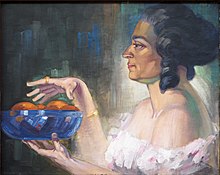Albert King
Albert König (born March 22, 1881 in Eschede , † February 5, 1944 in Unterlüß ) was a German painter .
Life

Albert König was born the son of the village blacksmith Albert Christoph König and his wife Caroline in Eschede in the Südheide . The father immigrated from East Prussia , the mother came from Baden . He grew up in the poorest of circumstances. In 1887 he lived with his mother and siblings in Königsberg. From 1889 to 1895 he worked as a shepherd boy near Eschede in addition to school. From 1903 to 1905, König did his military service. From 1915 onwards he served as a soldier in Masuria during the First World War . On September 27, 1919 he married the teacher Dorothea Borsdorff. In 1927, König moved to his newly built house in Unterlüß in the Celle district . Here he lived and worked in complete seclusion as a wood cutter and painter.
education
After attending school, in 1895 he began an apprenticeship with an Eschede decorative painter . In 1901 training at the School of Applied Arts in Dusseldorf . In 1909 he attended Heymann's private drawing school in Munich , and in December 1910 he went to Berlin . There he studied painting with Lovis Corinth , one of the most important and influential representatives of German Impressionism , and with Georg Tappert in Berlin. He remained friends with Tappert, who was almost the same age. In the summer of 1911, König returned to Eschede and now worked as a freelance artist. In 1913 he became a member of the German Association of Artists . His only major trip, through which he wanted to find new impressions, took him to Sicily in 1924 . In 1932, König received a scholarship from the German Albrecht Dürer Foundation of 400 Reichsmarks. He refused an admission into the Reich Chamber of Culture , which was requested in the 1930s .
Work
At the beginning of his work, his works show the influences of pointillism . In 1911 he returned to Eschede, where he made his first woodcuts and linocuts , which also earned him international recognition. After the end of the First World War, König dealt with Expressionism . In 1928 the first tree portraits and groups of trees were created using pencil technique. From the mid-1930s, König drew many nature studies in the kieselguhr pits near Unterlüß (→ Kieselguhr pits in the Lüneburg Heath ). In 1932 he created his first trees and groups of trees in oil and tempera painting with a completely unique language of shapes and images. On the basis of detailed drawings made beforehand, the large landscapes, groups of trees, trees and the sometimes fairytale alienated representations of the kieselguhr pits are created in the studio.
Awards
In 1912 he was awarded a bronze medal in the field of graphics at the International Art Exhibition in Amsterdam . Both in the last place of residence Unterlüß and in his place of birth Eschede a street is named after him.
Exhibitions
In 1941, on the occasion of his 60th birthday, a special exhibition was held in the Vaterländisches Museum , now the Bomann Museum in Celle . 46 tree pictures and seven diatomaceous earth landscapes were shown by him. In 1981, on his 100th birthday, his works were shown in the Gothic Hall in Celle Castle and in the gallery in the museum in Oldendorf .
Works
Through the will of his widow, the entire artistic estate of around 1,800 works as well as the house of the painter and graphic artist came into the possession of the community of Unterlüß, with the condition that an art museum was to be built which was to be named Albert-König-Museum . Ms. König was granted honorary citizenship of the Unterlüß community in March 1982. This museum was opened on June 19, 1987. The museum now has over 12,000 works by the artist in its archive through donations, permanent loans and purchases. The changing exhibitions each deal with closed topics from his work. The former home, in which, in addition to König's study and some of his work, changing exhibitions by other artists are shown, will later be expanded to include an exhibition hall. The permanent exhibition "Kieselguhr - The Adventure Exhibition" can be seen in the extension. The Kunsthalle Bremen , the Hamburger Kunsthalle , the Altonaer Museum , the Kunstmuseum Düsseldorf , the Bomann Museum Celle , the Helms Museum Harburg and the Museum Schloss Holdenstedt also have works by the artist.
Often artists painted their canvases several times, or like here, simply on the back, often for reasons of economy. The canvases were relatively expensive. The owner had to decide which side to show as a picture. König took the picture “Flohr-Mühle” , painted in 1916, and in 1927 painted the picture “Lupine Bouquet” on the other side of the canvas .
- Works by Albert König
Draft for a music book by Theodor Krüger
literature
- Volker Probst: Albert König The graphic work 1911–1941 . ISBN 9783927399051 .
Web links
- Literature by and about Albert König in the catalog of the German National Library
- Self-portrait and a selection of trees he painted
Individual evidence
| personal data | |
|---|---|
| SURNAME | King, Albert |
| BRIEF DESCRIPTION | German painter |
| DATE OF BIRTH | March 22, 1881 |
| PLACE OF BIRTH | Eschede , Lower Saxony |
| DATE OF DEATH | February 5, 1944 |
| Place of death | Unterlüß , Lower Saxony |
















